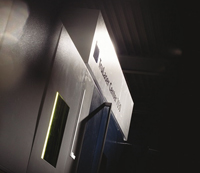19 October 2016
TRUMPF developers excel themselves with the TruLaser Center 7030
 At the Euroblech 2016, the TRUMPF TruLaser Center 7030 celebrated its world premiere.
At the Euroblech 2016, the TRUMPF TruLaser Center 7030 celebrated its world premiere.
“To succeed with a genuine innovative leap in this mature technology, we had to call all of the current development methods into question,” explained Heinz-Jeurgen Prokop, Managing Director Development and Purchasing at the TRUMPF Machine Tools division. As a result, a new form of cooperation was established. Around 100 employees worked on the project, with short work cycles and parallel to each other, across numerous sites and departments. And here they set the standards for all future TRUMPF development projects by being the very first to consistently apply ‘agile’ methods in a mechatronics project. The development goals were broken down into ‘sprints’, each of which lasted a few weeks until the next presentation of results. This led to lively exchanges and great transparency between all departments, while the development time of just two years from official project release was successfully kept extremely short. “Added to this was a new perspective – away from the existing machine concept, and toward a fresh look at the production task at the customer,” said Prokop.
Making productivity measurable
For this holistic approach, the developers simulated the entire production process for the very first time, and their thinking went far beyond the mere cutting process itself. They realized it was important to make productivity measurable – using real parts, and under real production conditions. To this end, the experts generated default sheet configurations representing the parts spectrum of TRUMPF customers. Here, they were supported by customers from many different sectors with several hundred set-up plans, which they could then evaluate statistically according to the relevant parameters. The result was a representative production program, nicknamed the “Urmeter” (the international prototype meter). “This enabled us to place a numeric value on all the problems our customers kept telling us about,” said Prokop. “Plus: we had a very specific means of measuring our ideas for solving those problems.” The overriding aim throughout was to save the customers 30 percent on processing costs.
In the past, most innovations had been geared toward increases in cutting speed, laser power and edge quality. Lothar Weber, Operations Manager at H.P. Kaysser GmbH + Co. KG and one of the test customers for the TruLaser Center 7030, explained: “When you’ve been in the business for 30 years, you realise that the machines are getting faster all the time, but that not much has changed where autonomy and processing are concerned. With thin sheet, the machines are so fast that sometimes you need three employees to get the parts out of them quickly enough.” As machines become ever faster, the focus shifts to interruptions and costly follow-up activities, all of which negatively impact overall productivity. These include having to wait until parts and skeletons have been sorted from the pallet, shutdowns caused by collisions involving parts tilting over, refinishing work on microjoints, splashes on the undersides of parts caused by backlash from the support slats, and excessive programming work.
A fully automatic machine that takes care of all processes autonomously
More than ever, this situation demands a solution. “The work has changed enormously. We’re producing far smaller quantities per batch than we used to, we’re nesting the tiniest of parts, and we have far more production orders each day where we have to sort the parts from ergonomically impractical pallet changers,” says Lothar Weber, describing one of the major problems caused by machines with flying optics and pallet-changers – a problem that has now been solved by the TruLaserCenter 7030, the new machine concept from TRUMPF. This laser machine takes care of a continuous automated production process all by itself. It can work autonomously over long periods, without the need for operator intervention. Moreover, it enables future developments that can make full use of all the possibilities inherent in digital and physical connectivity. Weber draws his own personal conclusion: “I think that in a couple years’ time we’ll have at least two more TruLaser Center 7030s at our plant. The machine is a real all-rounder. Batch sizes have been getting smaller for years now, and this highly flexible system is just what we need.”
- Contact Information
- Name: Gerry Jones
- Email: gerry.jones@uk.trumpf.com
- Website: www.uk.trumpf.com

